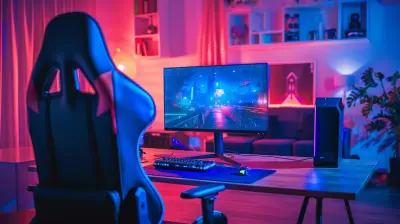How to Check Your PC’s Game Ready Status
23 November 2025
Alright, gamers, let me ask you something. Have you ever downloaded the latest, hottest game, fired it up, and boom—your PC starts wheezing like it just ran a marathon in flip-flops? Yeah, we've all been there. The truth is, not every PC is ready to take on the glorious, high-definition worlds that modern games throw at it. So before you start rage-uninstalling, let’s figure out how to check if your PC is truly prepared for gaming greatness. Spoiler alert: It's not rocket science, and no, you won’t need to dust off your college physics textbook. Let’s dive in!
Why "Game Ready" Matters
Picture this: You’re all set for a marathon gaming session, snacks on deck, beverages lined up, comfy chair adjusted just right. You load the game, and instead of smooth gameplay, it’s like watching a PowerPoint presentation from 2005. Slideshows are great for office meetings, but not for saving the digital world.Being "game ready" is simply ensuring your PC has what it takes to run the games you’re excited about. Think of it like checking your car before a road trip—tires inflated, oil checked, and gas tank full. Otherwise, you’re going nowhere fast. With PC gaming, it’s all about having the right hardware and software for a seamless experience.
Step 1: Know the Game’s Requirements
First things first: You need to know what you’re up against. Every game comes with a list of minimum and recommended system requirements. This is like the fine print on a contract, except it actually matters here. Developers usually list them on the game's website, Steam page, or wherever you’re looking to buy.Minimum vs. Recommended: What’s the Deal?
- Minimum Requirements: This is the bare-bones version. Your PC needs to meet these specs to run the game, but don’t expect it to look pretty. You’ll probably be playing with potato graphics that your grandma could sketch.- Recommended Requirements: Now we’re talking. If your PC aligns with these specs, your gameplay will be smooth, and the graphics will look like they were kissed by angels.
Pro Tip: Always aim for the recommended specs if you value your sanity. No one wants to lag during a boss fight.
Step 2: Know Your PC’s Specs (It’s Easier Than You Think!)
Alright, so you’ve got the game’s requirements pulled up. Now, how do you check what’s under your PC’s hood? Don’t worry—you don’t need to channel your inner Tony Stark for this.For Windows Users
1. Press `Win + R`: This opens the “Run” dialog box.2. Type `dxdiag` and Hit Enter: Welcome to the DirectX Diagnostic Tool, where all your PC's secrets are laid bare.
3. Look for Key Info:
- Processor (CPU): This is your PC’s brain. More cores = better multitasking.
- Memory (RAM): Think of this as your short-term memory. The more you have, the smoother things will run.
- Graphics Card (GPU): The artist of your rig. This determines how beautiful (or ugly) your games will look.
- Operating System: Make sure you’re running the latest version of Windows (because nothing screams "outdated" like Windows XP).
For Mac Users
- Honestly, just… why? Okay, jokes aside, click the Apple icon > About This Mac. All your specs are there. But be warned, Mac gaming is like trying to cut a steak with a butter knife. You can do it, but it’s not ideal.
Step 3: Compare and Judge (Yes, Judge)
Now that you’ve got your PC specs, it’s judgment time. Compare your PC’s numbers to the game’s requirements. Here’s how to judge your rig:- If your specs meet or exceed recommended requirements, you’re golden. Go ahead, crank those settings up to max!
- If your specs only meet the minimum, you can still play, but don’t expect it to look like a blockbuster movie. Think of it more like a made-for-TV budget flick.
- If your PC falls short on either, well... you’ve got some upgrading to do, my friend.
Step 4: Use Online Tools (Because Why Not?)
If you’re feeling lazy (no judgment—we’ve all been there), there are online tools that can do the dirty work for you. Tools like Can You RUN It (yes, that's their actual name) let you compare your PC’s specs against a game’s requirements without breaking a sweat. You just download a small app, run it, and voilà—it’ll tell you if your PC is up to snuff.But hey, take these tools with a grain of salt. They’re handy, sure, but nothing beats manually checking your specs for peace of mind.
Step 5: Update Your Drivers (Seriously, Do It)
Even if your PC meets all the requirements, outdated drivers can turn your gaming experience into a slideshow of frustration. Think of drivers as your PC’s instruction manual—they tell your hardware how to behave. If they’re outdated, chaos ensues.How to Update
- Graphics Drivers: Head over to the manufacturer’s website (NVIDIA, AMD, or Intel). They usually have handy tools that auto-detect your hardware and suggest updates.- Windows Updates: Yeah, I know, those pop-ups are annoying. But keeping your OS updated is key to a stable gaming experience.
- Optional Software: Some games require specific software like DirectX, .NET Framework, or Visual C++. Don’t ignore those installation prompts—they’re there for a reason.
Step 6: Run a Performance Test (Benchmarks, Baby!)
Okay, so your specs check out and your drivers are up to date. But can your PC actually handle the game in real-world conditions? Enter benchmarks—a fancy term for stress-testing your rig.Benchmarking Tools
- For Graphics Performance: Use tools like 3DMark or Heaven Benchmark to simulate gaming scenarios and see how your PC holds up.- Built-in Game Benchmarks: Some games come with a benchmark mode that tests your PC’s performance in-game. It’s like a trust fall for your rig.
Run a benchmark and pay attention to the FPS (frames per second). If you’re hitting 60 FPS or higher, congrats—your PC is ready to rock. Anything below 30 FPS? Time to dial down those settings or upgrade your hardware.
Step 7: Optimize Your PC for Gaming
Sometimes, even a decent PC can struggle if it’s bogged down by unnecessary junk. Here’s how to optimize your system:1. Close Background Apps: If your PC is juggling Spotify, Discord, Chrome (with 37 tabs open), and the game, something’s gotta give.
2. Adjust In-Game Settings: Lower the resolution, turn off shadows, or tone down lighting effects. Sacrifices must be made for the greater good.
3. Enable Game Mode: On Windows, enable Game Mode in settings to prioritize gaming performance over background tasks.
Bonus: When Upgrading Is Inevitable
If your PC’s specs are hopelessly outdated (sorry, but someone had to say it), you’ll need to upgrade. Focus on:- GPU: Your graphics card is the MVP of gaming performance.
- RAM: 16GB is the sweet spot for modern gaming.
- Storage: SSDs are life-changing—no more waiting 10 years for your game to load.
- CPU: Upgrade your processor if it’s bottlenecking your GPU.
Think of upgrading as giving your PC a new lease on life. Plus, it’s a great excuse to build your dream setup.
Wrapping It Up
And there you have it, folks—a step-by-step guide to checking your PC’s game ready status. At the end of the day, gaming should be fun and frustration-free. So take the time to prep your PC properly and avoid unnecessary heartbreak when your favorite game releases. Remember, a little effort upfront saves a whole lot of rage-quitting later.Now go forth, check those specs, and game on!
all images in this post were generated using AI tools
Category:
System RequirementsAuthor:

Brianna Reyes

